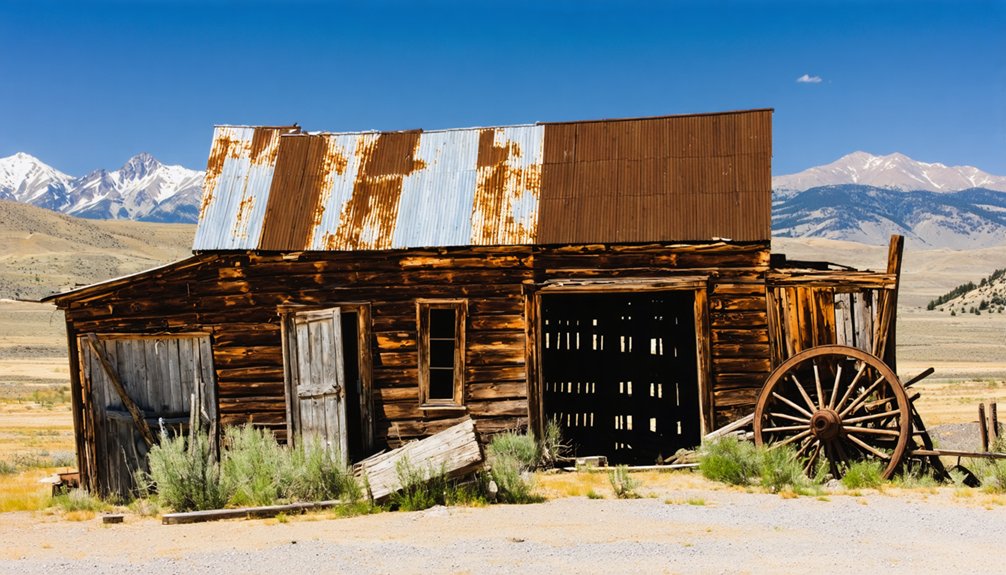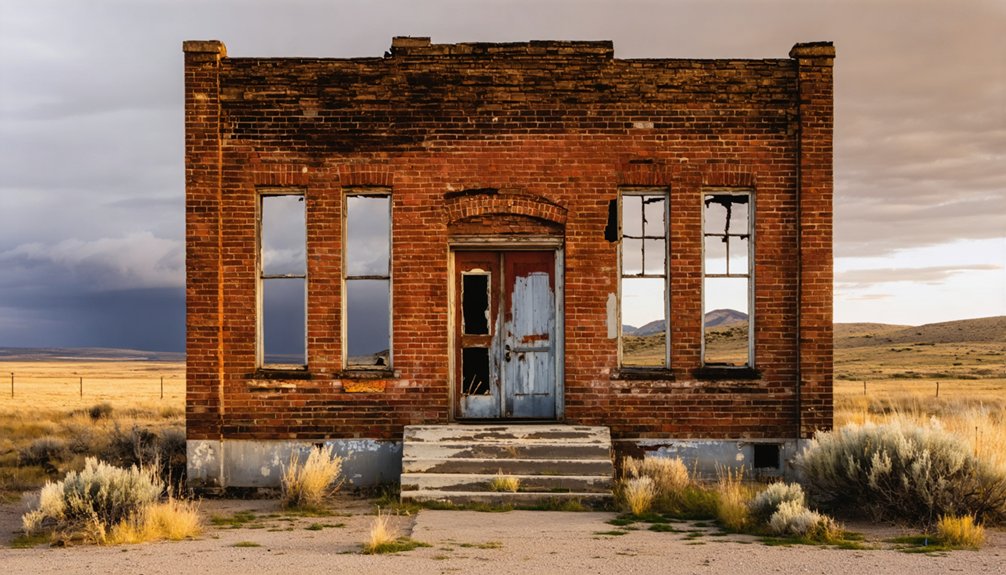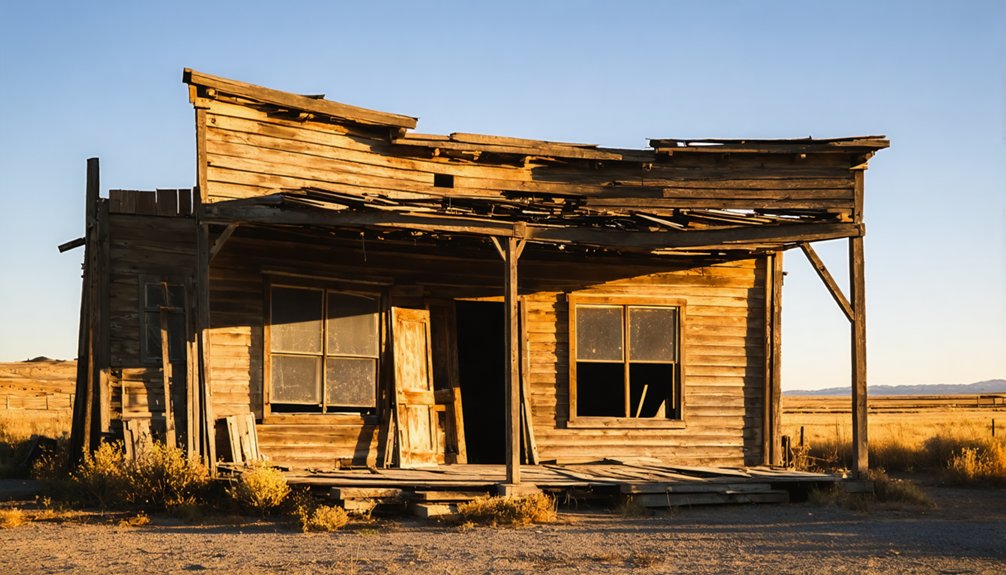You’ll find South Mountain City nestled in Idaho’s rugged terrain, where silver, copper, and cobalt were discovered in 1874. This bustling mining settlement grew around the Bullion Mine, purchased by E.A. Wall for $200,000 in 1882. The town featured Idaho’s only smelter and over 100 buildings at its peak, housing 4,000 residents. Today, roughly seventy-five historical structures remain, including the preserved 1892 Silver City School House and iconic Idaho Hotel, each holding untold stories of the American West.
Key Takeaways
- South Mountain City emerged in 1874 following mineral discoveries, with serious mining production beginning in 1939 for cobalt, copper, and gold.
- Bullion City, established in 1877, marked a significant development with the $200,000 purchase of the Bullion Mine by E.A. Wall.
- The mining community featured diverse residents, including veteran prospectors and Chinese immigrants, with infrastructure centered around saloons and stores.
- The town faced economic decline despite having Idaho’s only smelter, primarily due to harsh winters and remote location challenges.
- Approximately seventy-five historical structures from the 1860s and early 1900s remain preserved, including the 1892 Silver City School House.
The Birth of a Mining Boomtown
The discovery of South Mountain’s mineral wealth in 1874 marked a peculiar start to Idaho’s mining history, as the district initially attracted more stock promoters than serious miners.
In 1874, South Mountain’s discovery drew more financial speculators to San Francisco’s offices than miners to Idaho’s rugged terrain.
Unlike the bustling boomtowns that characterized Idaho’s silver rush, South Mountain’s early prospecting phase remained surprisingly quiet, with most of the action happening in San Francisco’s financial district rather than at the mining site.
You wouldn’t have found the typical rush of fortune seekers here during the 1870s. Instead, mining speculation dominated the scene, with minimal infrastructure and a sparse population. This was similar to early Flint, where rich gold deposits were initially mismanaged due to processing challenges.
While other Idaho mining camps transformed into thriving cities, South Mountain maintained its remote character. It wasn’t until 1939 that serious production began, turning this sleepy district into a legitimate mining operation focused on cobalt, copper, and gold. This was quite different from places like Silver City, which had reached peak populations around 4,000 during the height of their mining booms.
From Bullion City to South Mountain
As South Mountain’s early speculation period waned, Bullion City emerged in 1877 around the promising Bullion Mine, bringing a fresh wave of mining activity to the district.
You’ll find that the Bullion shift marked a shift from surface prospecting to sophisticated underground operations, with complex ore extraction reaching depths of 2,500 feet.
The area’s evolution intensified when E.A. Wall purchased the Bullion Mine for $200,000 in 1882, while the Philadelphia Mining and Smelting Company installed Idaho’s first electric lighting.
The change to South Mountain reflected growing industrialization, with over $1.5 million invested in infrastructure and new mining techniques. The Bullion Mine was later sold for 1,050,000 dollars with substantial ore reserves still remaining.
Historical records show the mine primarily extracted gold and silver from its granite host rock formations.
Though production slowed after 1912, intermittent drilling and tunneling continued through the 1920s as miners sought deeper copper deposits beneath the mountain’s weathered surface.
Life in an 1870s Mining Camp
Life in South Mountain’s mining camps reflected the diverse and often turbulent social fabric of 1870s frontier settlements. You’d find yourself among veteran prospectors, Chinese immigrants, and fortune seekers, all vying for opportunities in this male-dominated environment.
The social dynamics centered around saloons, hotels, and general stores, where you could escape the harsh realities of camp life. Supply transport was handled by skilled Mexican mule packers who navigated treacherous mountain paths to deliver essential goods. Similar to Placerville, the camp faced destructive fires that tested the community’s resilience.
Your daily routines would involve enduring crowded living conditions in wooden structures or basic shacks, battling severe mountain winters, and facing the physical demands of mining work.
Living in cramped shacks, miners braved harsh mountain winters while tackling the grueling physical labor of their daily work.
You’d rely on local merchants for supplies and might supplement your income with side jobs during off-seasons. The economic infrastructure grew quickly, connecting you to neighboring camps through trade networks, while the persistent Chinese workforce became essential to maintaining operations.
Mining Operations and Challenges
While South Mountain’s rich polymetallic deposits promised great wealth, miners faced significant operational hurdles in extracting the area’s zinc, silver, gold, copper, and lead reserves.
Similar to the pioneering flotation processes used at Bradley Mining Company’s mill, you’d have found the mountainous terrain particularly challenging, making it difficult to transport heavy machinery and ore. The complex geology demanded expertise and substantial financial investment that many small-scale operators simply couldn’t afford.
Today’s mining technology advancements have made extraction more efficient and environmentally conscious compared to historical methods. The operation aims to achieve a production rate of 750 tons daily.
The district now boasts over 8,000 feet of underground workings, though you’ll need to navigate strict environmental regulations to operate here.
Despite these challenges, the area’s high-grade mineralization and existing infrastructure continue to attract modern mining projects, especially since its location on private land simplifies the permitting process.
The Boom Years and Peak Activity
When gold placer deposits were discovered in 1866, South Mountain City transformed from untamed wilderness into a bustling frontier settlement. The gold rush fever spread rapidly, drawing hundreds of prospectors seeking their fortunes in the rugged Owyhee mountains. Over 4,000 residents moved to the area within the first year of settlement. Similar to nearby Stamping Mills in the region, mining operations quickly developed to process the ore.
You’ll find that mining culture thrived as the town quickly expanded to accommodate the influx of fortune seekers.
- Over 100 buildings sprung up, replacing the initial tent city with wooden structures.
- Idaho’s only smelter was established here, processing ore from Crown Point, Golconda, and other mines.
- Commercial enterprises flourished, including supply stores, saloons, and boarding houses.
- The post office’s establishment marked the town’s peak, though the population remained largely transient.
Despite primitive roads and harsh weather conditions, you’d have found a vibrant community during the boom years, accessible by stagecoach and horseback.
Architecture and Infrastructure
South Mountain City’s structures reflect the dual eras of its mining history, with most visible ruins dating to the 1950s rather than its 1870s origins.
You’ll find these later buildings constructed primarily of local materials, following the utilitarian designs common to mid-20th-century mining operations.
The town’s layout centered around its essential smelting operations, with residential and support structures arranged in proximity to what was once Idaho’s only operating smelter.
Building Materials and Construction
Three primary building materials dominated the construction landscape of this remote mining settlement: locally harvested timber, native stone, and metal components.
You’ll find that building techniques were remarkably practical, focusing on durability and function over aesthetics in this rugged environment. The town’s structures reflected the pioneering spirit of its inhabitants, with material choices driven by accessibility and necessity.
- Local timber formed the backbone of construction, used in everything from simple log cabins to the framing of ore processing facilities.
- Stone foundations and masonry work provided stability on uneven terrain and fire resistance for smelting operations.
- Metal components reinforced critical infrastructure, especially in mills and ore processing facilities.
- Wood shingles or metal sheets topped most buildings’ gabled roofs, protecting against harsh mountain weather.
Town Layout and Design
The layout of this mining settlement reflected careful planning despite its frontier origins, with streets arranged in a practical grid pattern to support mining operations and smelter access.
You’ll find evidence of thoughtful industrial design, where road accessibility enabled efficient transport of ore and supplies between the mines and Idaho’s only smelter.
The town layout balanced residential clustering with mining infrastructure needs. Workers’ homes were strategically positioned near mine sites while maintaining access to community facilities like the post office and gathering halls.
You can trace how environmental adaptation influenced the settlement’s design, with buildings arranged to withstand cool winters and heavy snows.
The street patterns created an efficient network connecting residential areas to essential industrial zones, optimizing the town’s functionality as a mining hub.
The Path to Abandonment

Mining operations at South Mountain City faced multiple challenges that ultimately led to its downfall. The town’s economic decline began despite having Idaho’s only smelter and several productive mines in the district.
You’ll find that a combination of factors contributed to its eventual abandonment, including environmental challenges like harsh winters that made year-round operations difficult.
- The remote location, about twenty miles from Jordan Valley, created significant transportation and supply challenges.
- As mining activities decreased across the region, the town’s economic foundation began to crumble.
- Limited infrastructure and lack of modernization made it difficult to compete with more advanced mining operations elsewhere.
- Post-war economic shifts in the late 19th century dealt a final blow to the town’s sustainability, though some mining briefly resumed in the 1950s.
What Remains Today
While South Mountain City‘s active mining days are long past, present-day visitors will find remarkable traces of its frontier heritage scattered throughout this historic settlement.
You’ll discover approximately seventy-five historical structures dating back to the 1860s and early 1900s, showcasing early Idaho architecture. The town’s cultural significance is evident in preserved landmarks like the 1892 Silver City School House, which served the community until World War II.
Today, four seasonal businesses operate during summer months, offering glimpses into the region’s mining past. The Idaho Hotel stands as a symbol of preservation efforts, maintaining its original charm while incorporating minimal modern amenities.
High in the Owyhee Mountains, the town continues to attract history enthusiasts who appreciate its authentic rustic character.
Legacy and Historical Impact

Since its establishment in the early 1870s, South Mountain City has left an indelible mark on Idaho’s mining heritage through its groundbreaking industrial achievements.
The town’s cultural significance extends far beyond its physical remains, shaping the region’s development and character.
Here’s how South Mountain City influenced Idaho’s history:
- It housed Idaho’s only smelter for several years, revolutionizing mineral processing capabilities throughout the territory.
- The town’s economic impact reached beyond local boundaries, creating essential trade networks and employment opportunities.
- Its diverse mining community helped establish the multicultural foundation of early Idaho settlements.
- The site continues to serve as a symbol of technological innovation, showcasing early industrial advancements in America’s western mining operations.
Frequently Asked Questions
Are There Any Documented Paranormal Activities or Ghost Sightings in South Mountain City?
You won’t find any officially documented ghostly encounters here – while local legends might hint at paranormal activity in abandoned mines and buildings, there’s no confirmed evidence of supernatural occurrences.
How Dangerous Is the Journey to South Mountain City During Winter Months?
You’ll face extreme winter safety risks with limited emergency access, dangerous road conditions, and potential isolation. Don’t attempt the journey without proper travel precautions and a well-equipped 4WD vehicle.
Which Valuable Artifacts Have Been Discovered by Modern Visitors to the Site?
Like treasures in nature’s vault, you’ll find mining tools, gold lockets, ore processing equipment, and photos at the site. However, artifact hunting’s restricted – these items need historical preservation for future generations.
Were There Any Notable Crimes or Gunfights During South Mountain City’s Peak?
You won’t find documented gunfights history or significant crime stories from South Mountain City’s peak period. While frontier mining towns often saw violence, there’s no evidence of notable criminal incidents here.
What Indigenous Tribes Originally Inhabited the Area Before South Mountain City’s Establishment?
Like ancient spirits of the land, you’d find the Northern Paiute and Western Shoshone peoples thrived here first, adapting to Great Basin’s harsh terrain through seasonal movements for thousands of years.
References
- https://www.youtube.com/watch?v=AQMyV46_T1I
- https://idaho-forged.com/idahos-ghost-towns-eerie-yet-approachable/
- https://www.owyheejack.com/owyhee-jacks-meanderings/south-western-idaho/ghost-towns-near-silver-city
- https://www.ghosttowns.com/states/id/southmountaincity.html
- https://www.idahomagazine.com/article/war-eagle-mountain-mining-idaho/
- http://freepages.rootsweb.com/~gtusa/history/usa/id.htm
- https://visitidaho.org/things-to-do/ghost-towns-mining-history/
- https://westernmininghistory.com/towns/idaho/silver-city/
- https://history.idaho.gov/wp-content/uploads/2018/08/0009.pdf
- https://www.oregonhistoryproject.org/articles/historical-records/mining-sections-of-idaho-and-oregon-1864/



